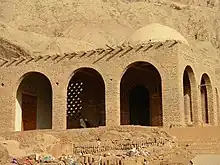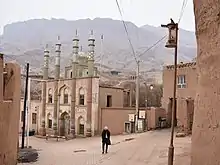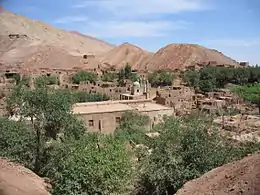Tuyoq valley
Tuyoq or Tuyugou or Tuyuk (Chinese: 吐峪沟; pinyin: Tǔyùgōu; Uyghur: تۇيۇق) is an ancient oasis-village in the Taklamakan desert, 70 km east of Turpan in Shanshan County[1] in a lush valley cutting into the Flaming Mountains, with a well preserved old Uyghur style village, and few tourists. It is famous for its seedless grapes and a number of ancient Buddhist grottoes meditation caves nearby containing Buddhist murals and frescos.[2]

Mosque in Tuyoq

The main mosque of Tuyoq village

Tuyoq village, Xinjiang, China.
Footnotes
- "2017年统计用区划代码和城乡划分代码".
- Bonavia (2004), pp. 241-242.
References
- Bonavia, Judy (2004). The Silk Road: Xi'an to Kashgar. Revised by Christoph Baumer. Odyssey Guides. Hong Kong. ISBN 962-217-741-7.
Wikimedia Commons has media related to Tuyoq Village.
This article is issued from Wikipedia. The text is licensed under Creative Commons - Attribution - Sharealike. Additional terms may apply for the media files.